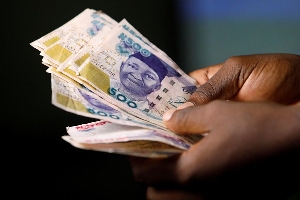The Nigerian currency weakened in the official market while Nigeria’s headline inflation readings rose to a three-decade high in May, worsening the naira’s fortunes in the short term.
Data from the FMDQ Securities Exchange Limited shows the naira lost 0.45% of its value after trading on Friday, with the dollar quoted at N1,482.72, weaker than the N1,476 posted on Thursday at the Nigerian Autonomous Foreign Exchange Market.
Voluntary sellers and buyers of dollars increased their supply by 96.6% to $183.47 million on Friday, up from $92.68 million on Thursday.
The intraday high worsened to N1,490 against the greenback on Friday compared to N1,500/$1 offered on Thursday.
Nigeria’s inflation rate at three decade-high
Data from the National Bureau of Statistics revealed that consumer prices increased by an annual 33.95%, up from 33.7% in April. Food prices rose due to increased costs for meat, fish, and potatoes. Food inflation increased from 40.3% in April to 40.66% in May, while core price growth, which excludes energy and agricultural products, accelerated to 27% from 26.8%. Inflation was also fueled by the naira’s rapid decline against the US dollar since June of last year.
The weakening currency has raised import prices on food. Nigeria’s economy heavily depends on imports, and Nigerian importers are purchasing items at exorbitant costs. Higher tariffs resulting from the naira’s depreciation have further increased the prices of some goods.
Nevertheless, there might be some respite for the naira in the mid-term. A $2.25 billion package, approved by the World Bank, was given to Nigeria to stabilize the economy and increase aid to the poor and vulnerable to economic shocks, given that, after India, Nigeria has the largest proportion of impoverished individuals worldwide. The funds will also bolster the nation’s foreign exchange reserves, supporting the naira.
The dollar index experienced volatility. The Federal Reserve meeting on Wednesday and the release of US inflation statistics caused significant swings in the dollar’s value. Following the release of the inflation statistics, which showed a slight slowdown from the previous month, the dollar index initially fell sharply.
Hawkish Fed brightens the U.S. dollar index
The US Dollar Index (DXY) indicated a strong week for the Greenback, ending around 105.80, levels last seen in early May. The index rose for the second consecutive week, buoyed by renewed political concerns in the European Union and expectations that the Fed will maintain its tighter-for-longer policy stance.
The US money market was unaffected by the robust rebound in demand for the greenback, as the demand for fixed-income instruments remained strong, dragging rates to multi-week lows across various maturity periods.
Business News of Monday, 17 June 2024
Source: nairametrics.com













